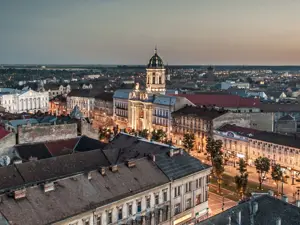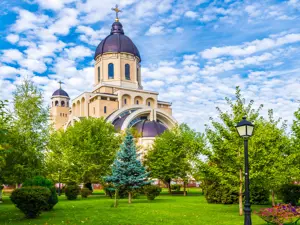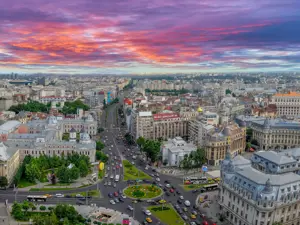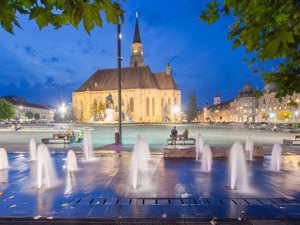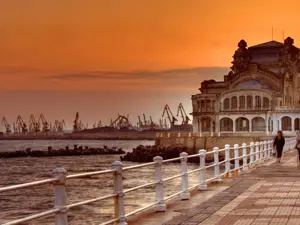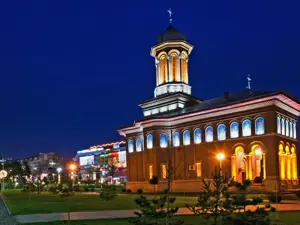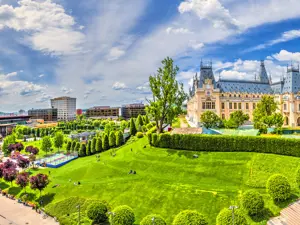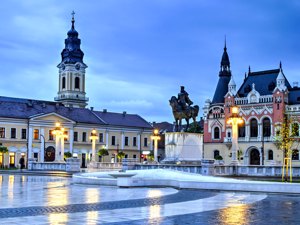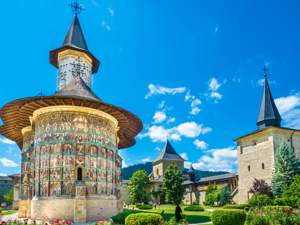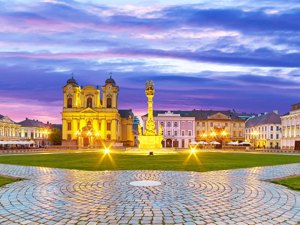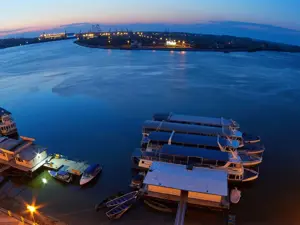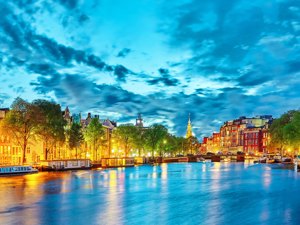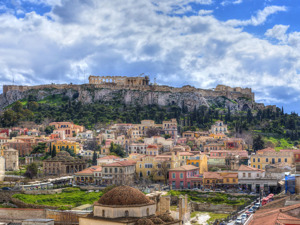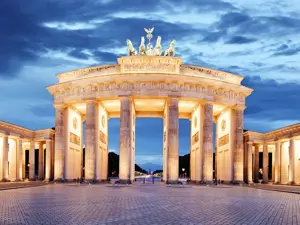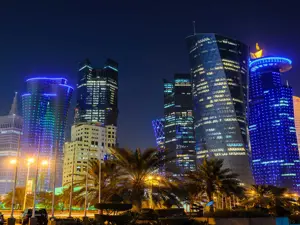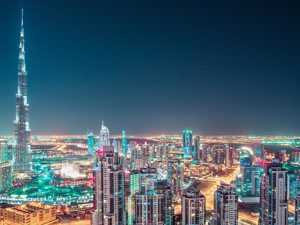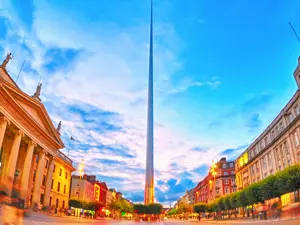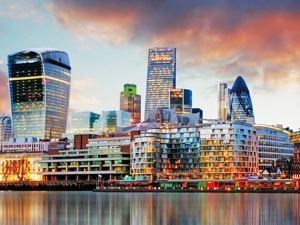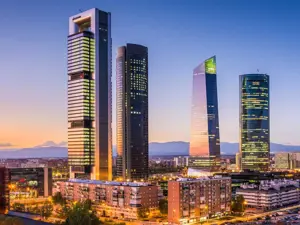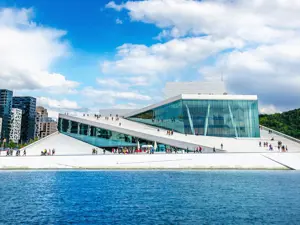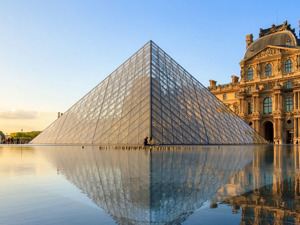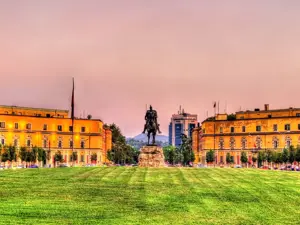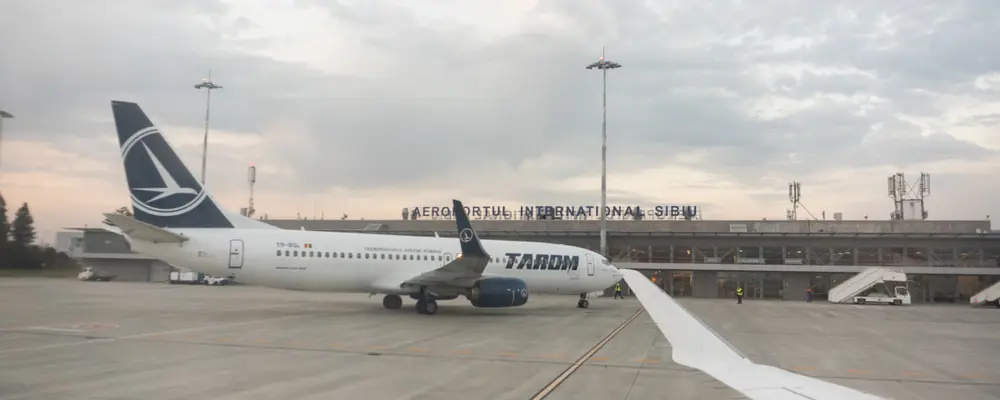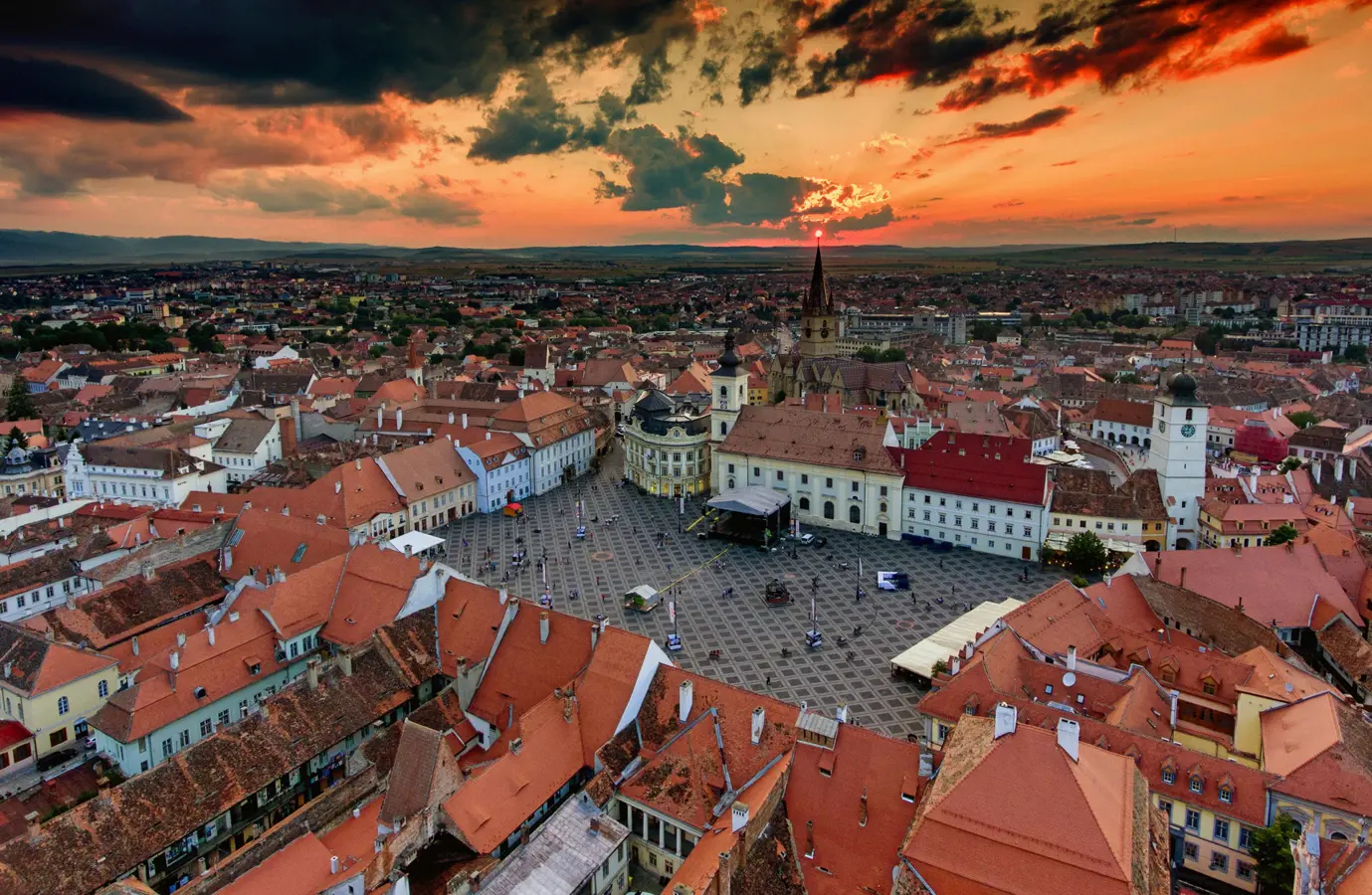
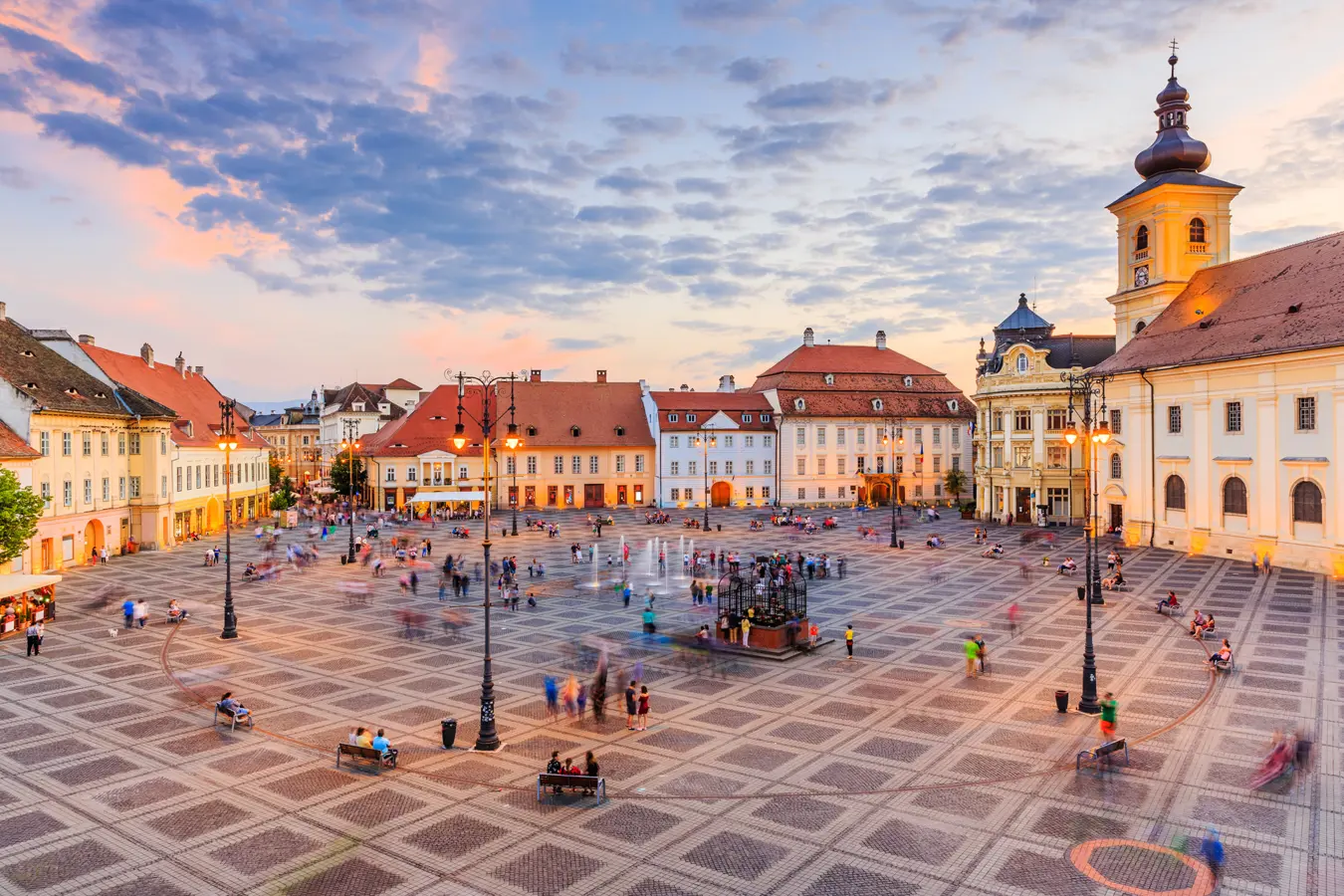
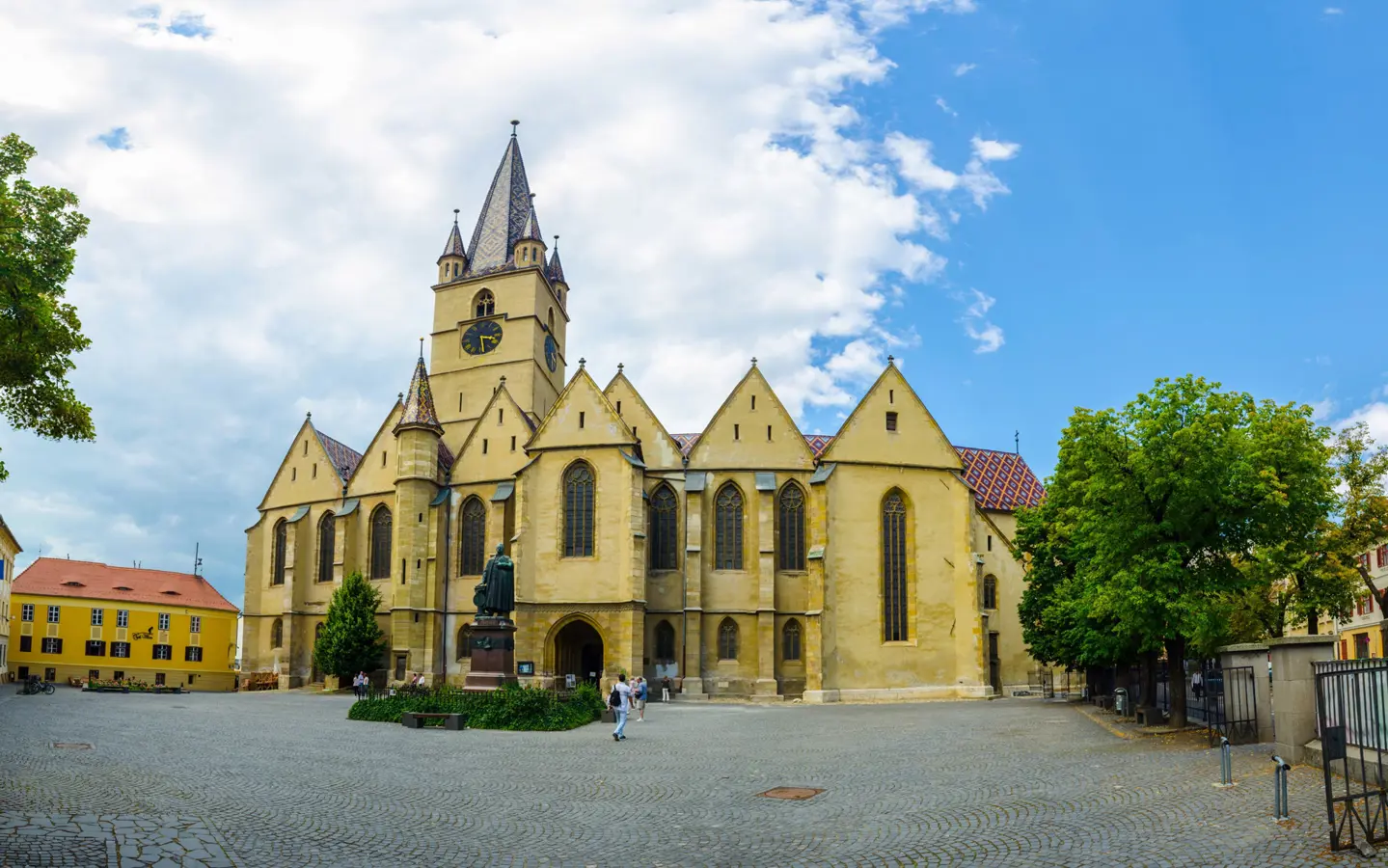
Huet Square is also found in the historic centre. It is overlooked by two important buildings: the Evangelical Lutheran Church, built in the fourteenth century, and the Brukenthal High School.
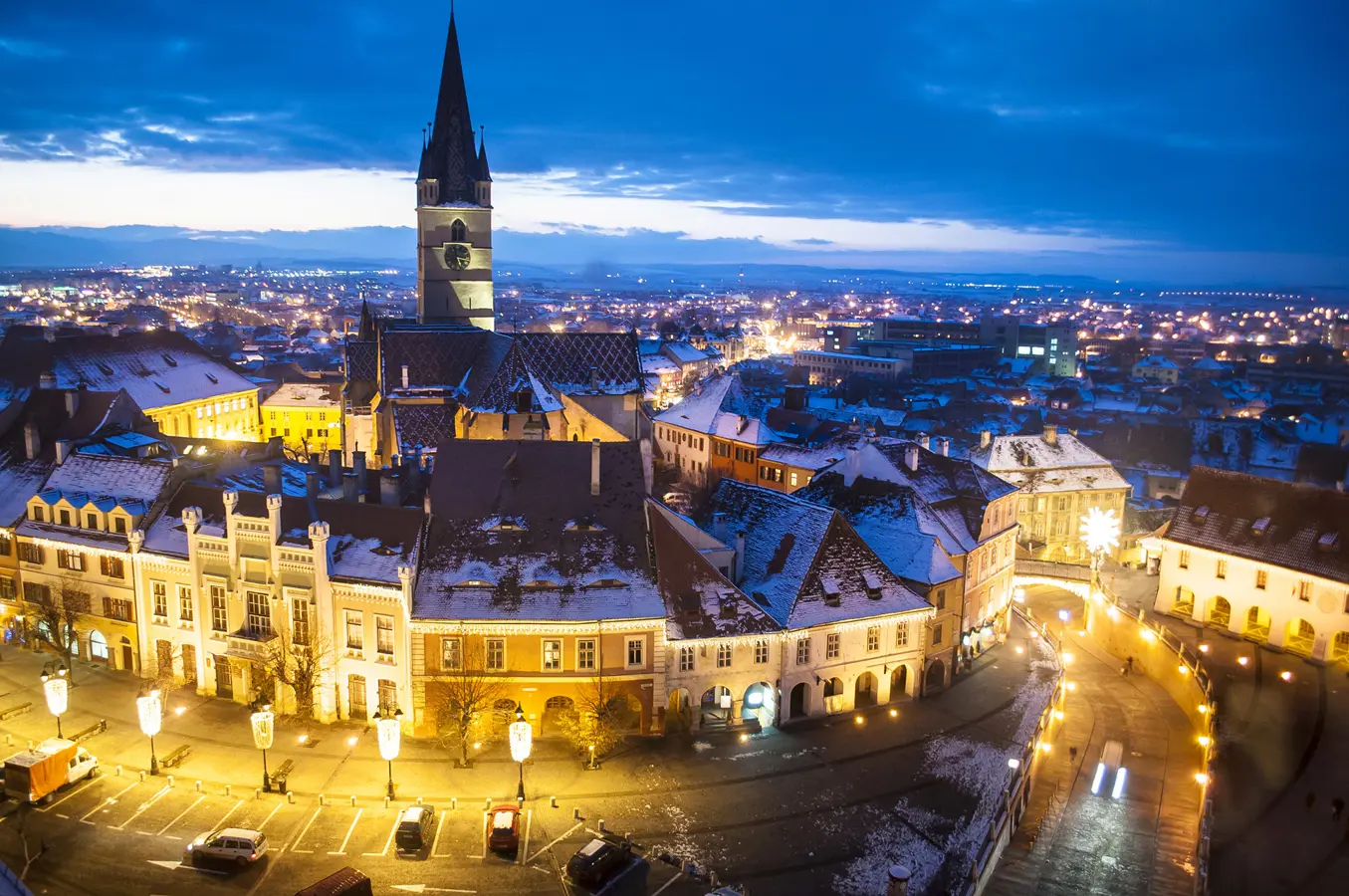
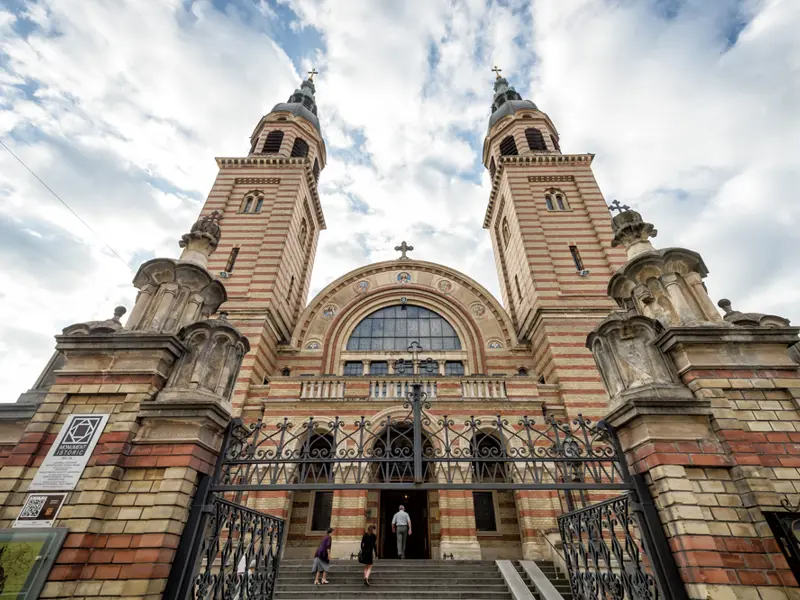
ORTHODOX CATHEDRAL OF THE HOLY TRINITY
The Orthodox Cathedral of the Holy Trinity in Sibiu stands on the site of the former Greek Church (1797-1799). Construction of the current building began in 1902 and was completed in 1906. Designed in the Neo-Byzantine style, it draws inspiration from the Hagia Sophia Basilica in Constantinople, reinterpreted with Transylvanian and Baroque influences. The two towers, about 45 meters high, are topped with onion-shaped domes.
Inside, the cathedral preserves Art Nouveau-style frescoes, including the work of Octavian Smigelschi, who decorated the dome. Since 1906, it has been the seat of the Archbishopric of Sibiu and the Metropolis of Transylvania.
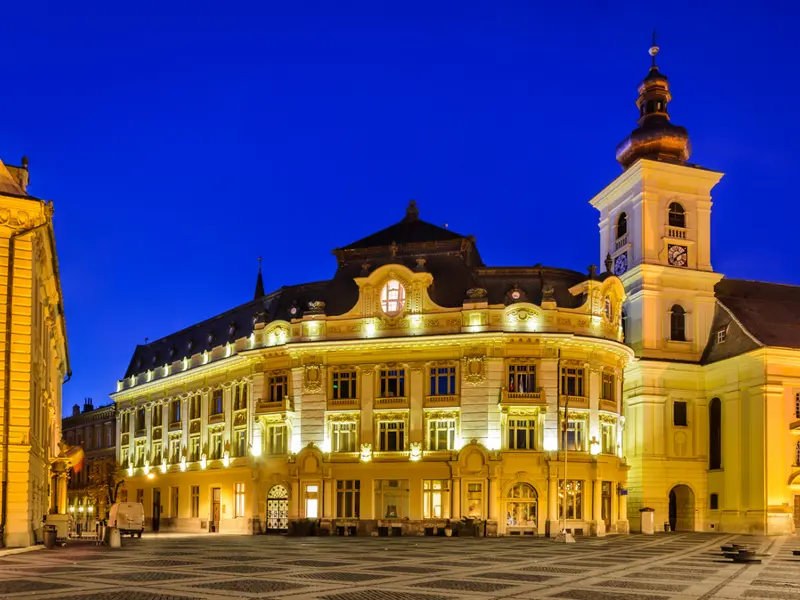
CHURCH OF THE HOLY TRINITY IN SIBIU
The Church of the Holy Trinity in Sibiu, also known as the Jesuit Church, is a Roman Catholic church located at 3 Piața Mare. It was built by the Jesuits between 1726 and 1733 and features stained glass windows crafted in Budapest in 1901.
Situated right next to the Brukenthal Palace, it is considered one of the most important Baroque churches in Transylvania. The church is listed as a historic monument by the Romanian Ministry of Culture and Religious Affairs.
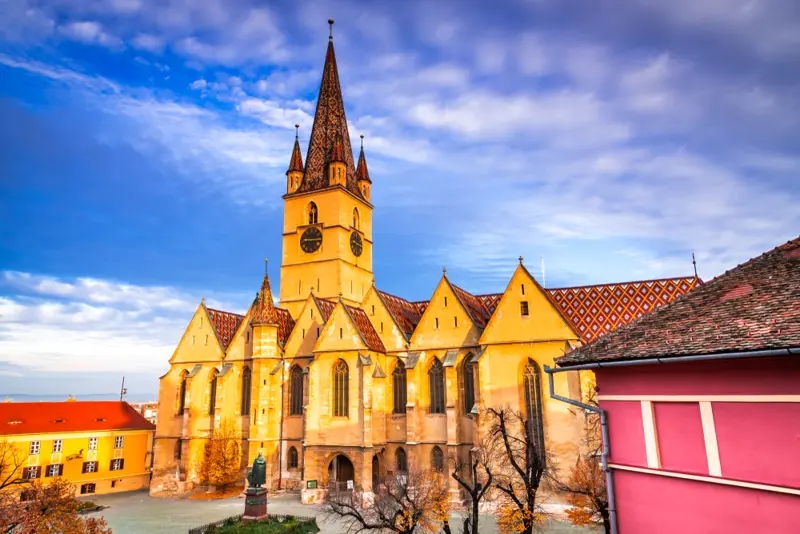
EVANGELICAL CHURCH OF SIBIU
The Evangelical Cathedral of Sibiu, one of the most iconic landmarks of Transylvania, stands on the site where a Romanesque basilica once stood in the 12th century. The current building, constructed between 1300 and 1520, is a remarkable example of Gothic architecture, distinguished by its five-pointed bell tower rising to a height of 73.34 meters. At the top, four corner turrets can be seen, symbolizing the city’s historical privileges. Inside, the cathedral houses a bronze baptismal font dating from 1438, adorned with 228 reliefs depicting sacred and everyday scenes - an outstanding example of late medieval art. On the western wall stands the fresco of the “Crucifixion of Jesus” (1445) by the painter Johannes von Rosenau, considered a masterpiece of Gothic painting in Transylvania. Since 1867, following the transfer of the Saxon Lutheran bishopric from Biertan to Sibiu, the church has held the status of a cathedral.
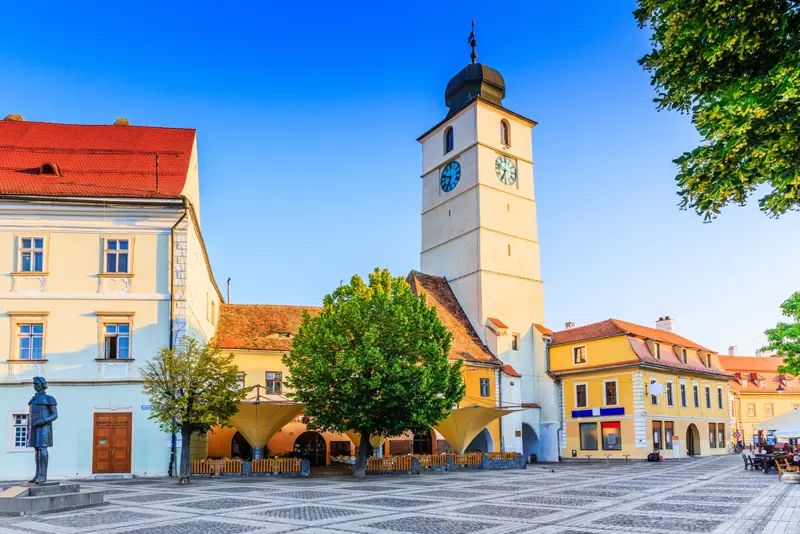
COUNCIL TOWER OF SIBIU
The Council Tower of Sibiu, once the main gate of the city’s second line of fortifications, still preserves its original medieval core. Archaeological excavations carried out in the defensive moat uncovered a coin dating from 1205-1235, during the reign of Andrew II of Hungary, confirming the ancient origins of the site. The tower’s current appearance dates back to restoration works between 1586 and 1588, while in 1826 an additional floor and a copper roof were added, giving it its present height and silhouette. Inside, a spiral staircase of 141 steps leads to the panoramic terrace, passing the sixth floor, where the historic clock mechanism is housed. Over the centuries, the tower has served various purposes - from grain storage to fire watchtower, and later, in the 19th century, as the site of a natural history museum. Between 1962 and 1998, it hosted a section of the Brukenthal Museum dedicated to medieval art, further cementing its cultural and historical significance within the city of Sibiu.
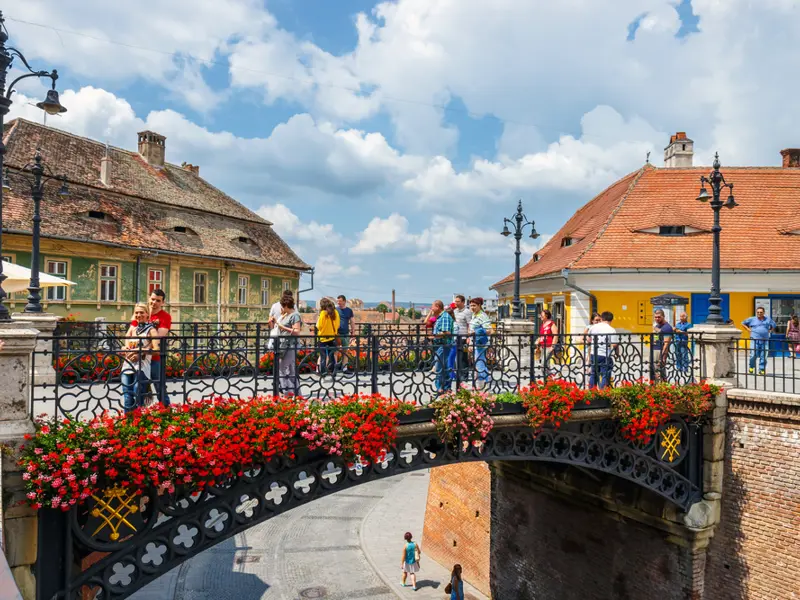
LIER BRIDGE IN SIBIU
The Bridge of Lies, one of Sibiu’s most iconic landmarks, is a pedestrian bridge located in the heart of the city, connecting Small Square (Piața Mică) with Huet Square. Built in 1859, it is considered the first cast-iron bridge in Romania, a remarkable example of 19th-century engineering and design. Supported by four cast-iron arches decorated with Neo-Gothic motifs, the bridge features on its southern arch the coat of arms of Sibiu, while the northern side bears the inscriptions “1859” and “Friedrichshütte”, the German foundry that produced its components. The ornate railings, made up of eight perforated panels with circular and Gothic patterns, add to the bridge’s elegant and balanced structure. Surrounding the bridge is an aura of legend and mystery. According to local folklore, the most famous tale claims that the bridge will collapse beneath anyone who dares to tell a lie while crossing it, a belief that continues to enchant visitors and locals alike.
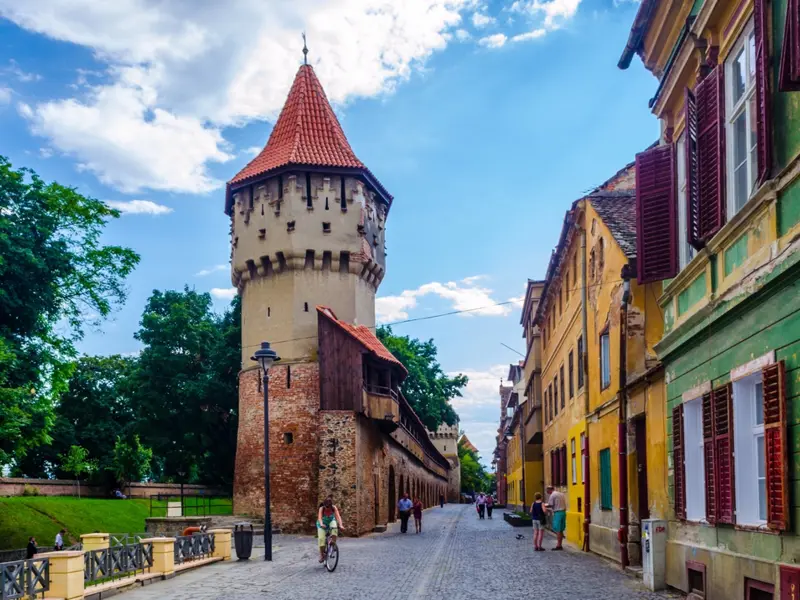
DEFENSE TOWER AND WALLS IN SIBIU
In Sibiu, the remnants of the city’s medieval fortifications still stand as a testament to its strategic past. Beginning in the 16th century, the city was once encircled by three concentric defensive walls punctuated by 39 towers, each maintained by a different guild. Today, only seven towers remain, including the Turnul Dulgherilor (Carpenters’ Tower) and the Turnul Archebuzierilor (Arquebusiers’ Tower) from the 14th century, as well as the Turnul Olarilor (Potters’ Tower) from the 15th century, all positioned along the old walls and moat. Among the best-preserved bastions are the Thick Tower, the Haller Bastion, and the Soldisch Bastion, the latter built between 1622 and 1627 as the final addition to the city’s fortifications. The Soldisch Bastion still displays a white marble coat of arms, and on its northern wall, four embedded cannonballs serve as enduring evidence of its defensive purpose.
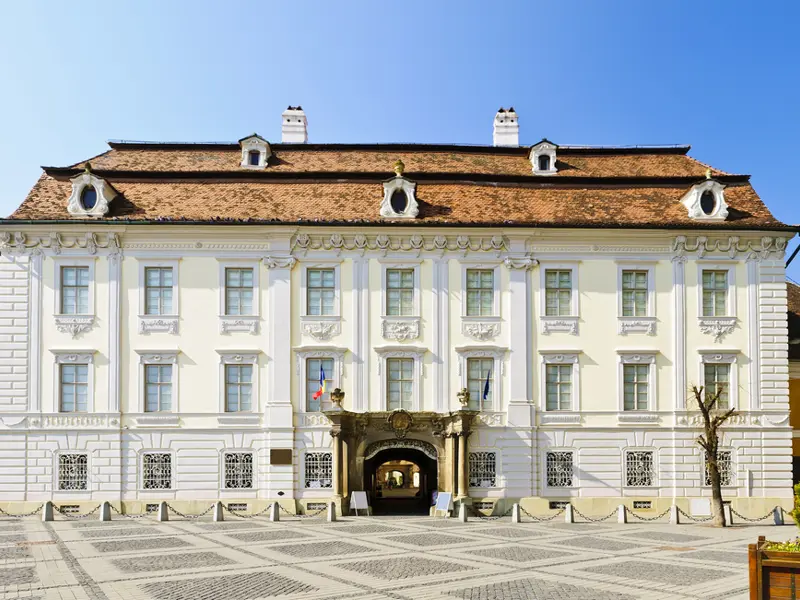
BRUKENTHAL MUSEUM IN SIBIU
In the heart of Sibiu, on the historic Piața Mare, stands the Brukenthal Palace, a masterpiece of Baroque architecture built between 1778 and 1788 at the request of Baron Samuel von Brukenthal, then Governor of Transylvania. Designed with a rectangular layout, the palace features four wings enclosing a central courtyard, while its main façade is distinguished by a stone portal supported by columns and adorned with garlands, urns, and the baron’s gilded coat of arms - a refined tribute to Viennese Baroque elegance. Since 1817, the palace has housed the Brukenthal National Museum, which preserves the baron’s extensive collections of European paintings, prints, coins, and rare books, making it one of the oldest and most prestigious museums in Romania.
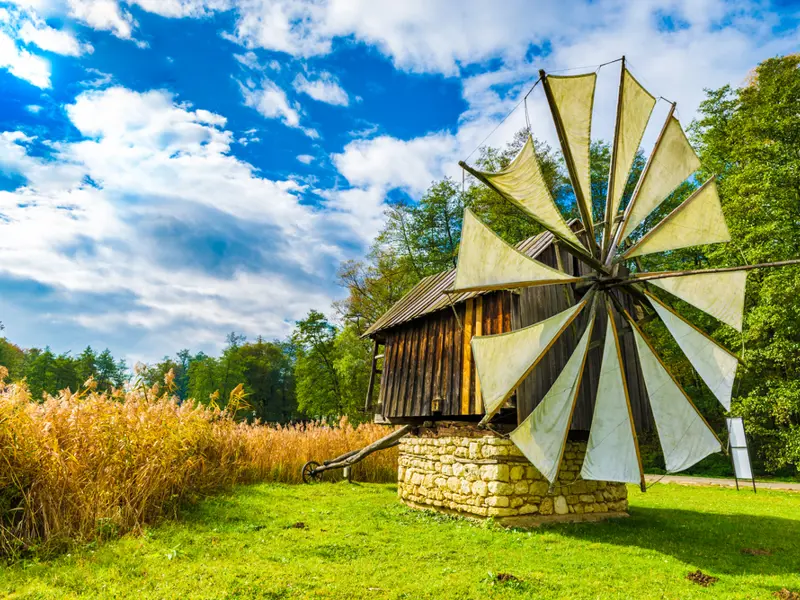
MUSEUM OF THE ASTRA VILLAGE
The ASTRA National Museum Complex, located in the Dumbrava Forest, just 6 kilometers from the center of Sibiu, is one of Europe’s largest open-air museums, blending nature, history, and culture in a unique environment. It features over 400 traditional buildings and around 200,000 artifacts showcasing Romania’s rural heritage. The museum recreates the authentic atmosphere of traditional village life: windmills, wooden churches, craft workshops, and peasant homes from various regions of the country line scenic pathways surrounded by lush greenery.
Beyond its exhibitions, museum actively promotes educational and interactive programs, fostering an appreciation for both tangible and intangible heritage, and encouraging cultural dialogue, sustainability, and the development of rural communities.

SIBIU ZOO
The Sibiu Zoo, nestled in the Dumbrava Sibiului Forest, offers visitors a day immersed in nature and discovery. This charming zoo features a scenic lake, a children’s playground, and a diverse range of wildlife (from bears to zebras) making it a delightful destination for families and animal lovers alike. Home to over 300 animals representing 74 different species, the zoo provides an inviting natural setting just a few minutes from Sibiu’s historic center. It’s the perfect place for a relaxing walk, close encounters with animals, or a fun and educational outing - an experience that captivates both children and adults.
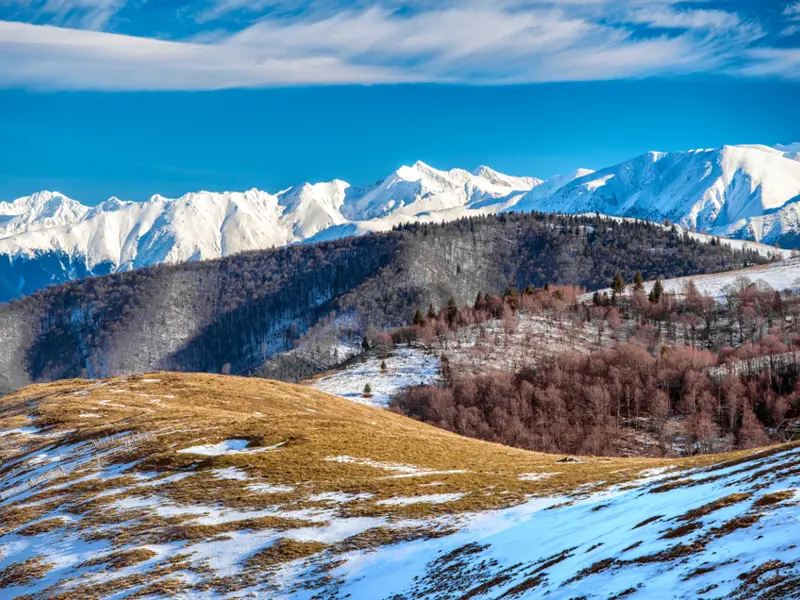
PĂLTINIŞ RESORT
Păltiniș, nestled in the Cindrel Mountains of Transylvania, about 35 kilometers from Sibiu, is the highest mountain resort in Romania, standing at an altitude of 1,440 meters. Surrounded by dense coniferous forests, it offers breathtaking alpine scenery and pure, refreshing air. In winter, Păltiniș is a favorite destination for skiers and winter sports enthusiasts, while in summer it attracts hikers and nature lovers seeking peace, panoramic trails, and unspoiled landscapes. The area features a variety of hotels, chalets, villas, and private vacation homes, providing comfort in a serene mountain setting. At the entrance to the resort stands a Romanian Orthodox monastery, which houses the tomb of philosopher Constantin Noica, who spent the final years of his life in Păltiniș, finding inspiration in its tranquil beauty.
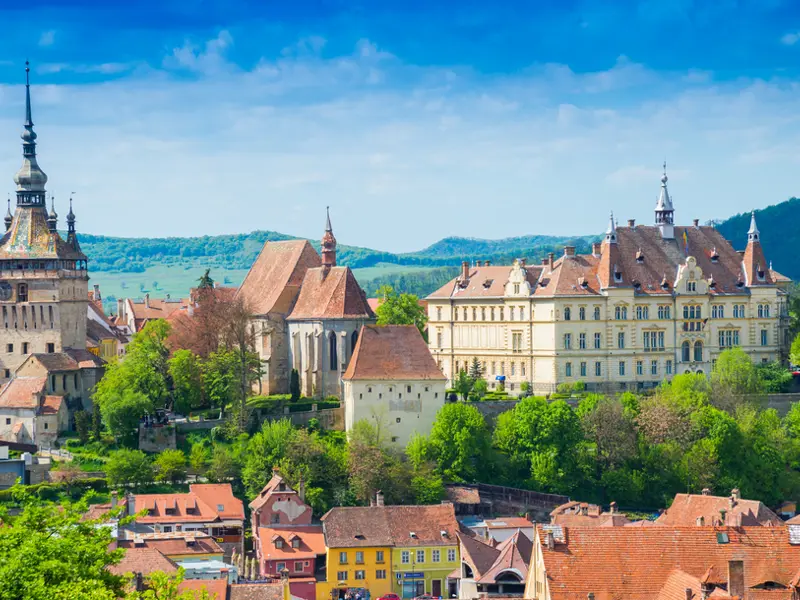
SIGHISOARA
Sighișoara, overlooking the Târnava Mare River in Mureș County, is one of Transylvania’s most captivating medieval jewels. Renowned for its historic center, designated a UNESCO World Heritage Site in 1999, the city stands as one of the best-preserved inhabited fortified towns in Eastern Europe. Its urban layout is divided into two distinct areas: the Citadel (Cetatea) - perched on a hill and surrounded by ancient walls and defensive towers - and the Lower Town, which unfolds gracefully along the valley of the Târnava Mare. Every July, Sighișoara’s cobblestone streets and charming squares come alive during the Medieval Festival, a vibrant celebration of history, music, and tradition that transports visitors back in time. Located about 90 kilometers from Sibiu, Sighișoara is a must-visit destination for those exploring the heart of Transylvania.
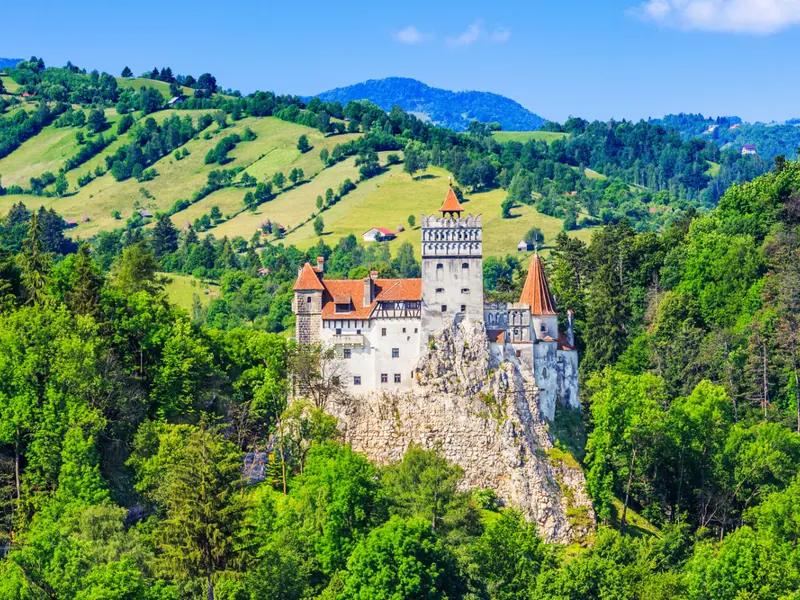
BRAN CASTLE
The Bran Castle, located near the village of Bran in Brașov County, is one of Romania’s most iconic landmarks and a timeless symbol of Transylvania. Perched dramatically on a rocky hill at the border between Transylvania and Wallachia, along National Road 73, the castle dominates the landscape with its fairy-tale silhouette. Known worldwide as “Dracula’s Castle”, its fame stems from Bram Stoker’s novel, which imagined it as the residence of the legendary vampire count. In reality, the castle has medieval origins: built in the 14th century as a fortified stronghold, later serving as a noble residence and a strategic outpost between the two regions. Today, Bran Castle houses a museum dedicated to the history of Transylvania and the collections of the Romanian royal family, featuring period furnishings, artworks, and historical artifacts. The castle lies 135 kilometers from Sibiu.
Partnership with GetYourGuide
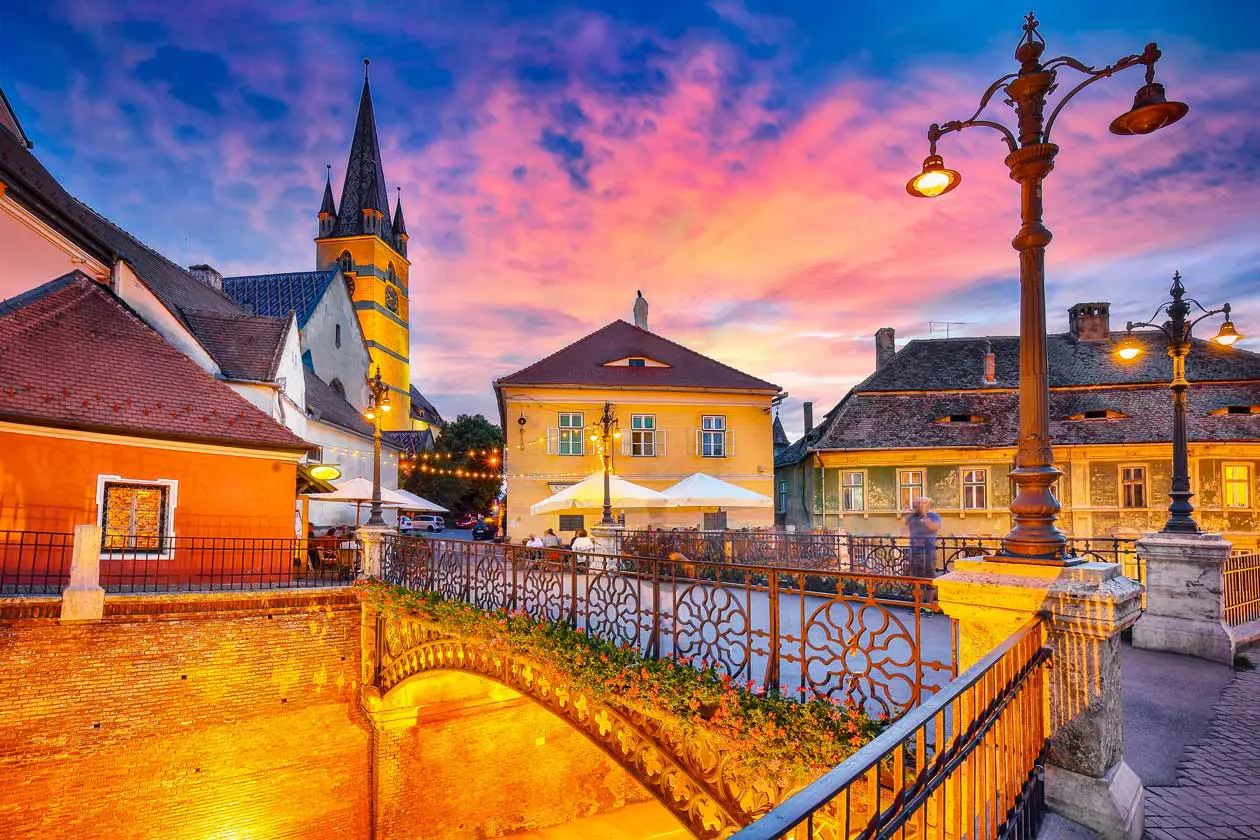
Sibiu city tour
Discover the medieval charm of Sibiu with an expert local guide on a walking tour through its historic heart. Explore the city’s main landmarks, including Piața Mare (Grand Square), the Brukenthal Palace, the Council Tower (Turnul Sfatului), Piața Mică (Small Square), the Bridge of Lies (Podul Minciunilor), and Piața Huet with its magnificent Evangelical Cathedral. The tour also includes a visit to the Orthodox Cathedral in Piața Unirii and the Brukenthal National Museum, housed within the elegant baroque palace of the same name. Duration: 2 hours. Free cancellation and full refund available up to 24 hours before the tour. Booking.
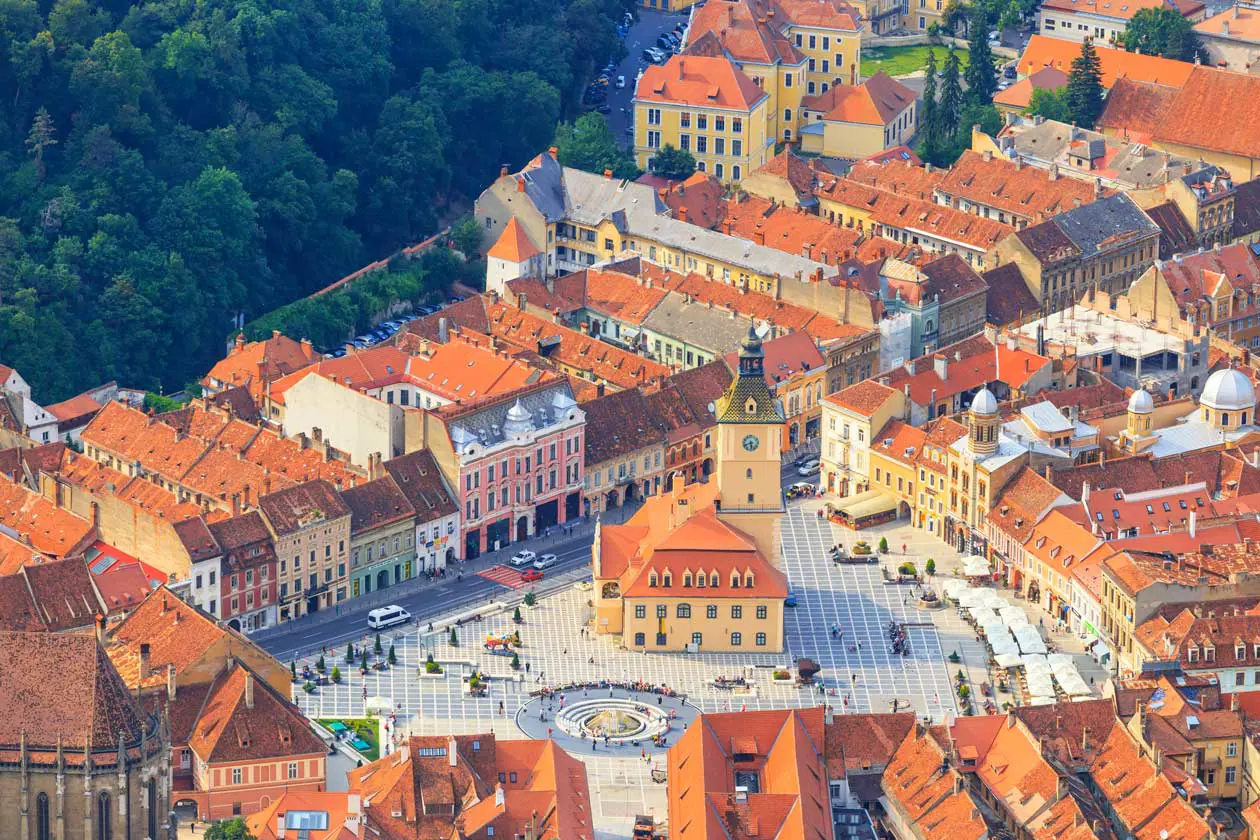
From Sibiu: trip to Brașov and Bran Castle
Guided excursion from Sibiu to explore two of Transylvania’s most captivating destinations: the Bran Castle and the medieval city of Brașov. Visit the Bran Castle, famously linked to Vlad the Impaler and Bram Stoker’s Dracula, and step inside its medieval chambers, hidden passageways, and dungeons, while enjoying views of the surrounding Carpathian Mountains. The castle also houses a museum featuring 14th-century furniture and historical artifacts. Continue to Brașov, a Transylvanian city nestled at the foot of the Carpathians, renowned for its Gothic, Baroque, and Renaissance architecture and its medieval atmosphere. Includes: round-trip transportation from Sibiu by bus, driver, and professional guide. Duration: 1 day. Free cancellation and full refund available up to 24 hours before the tour. Booking.
All tours and excursions



